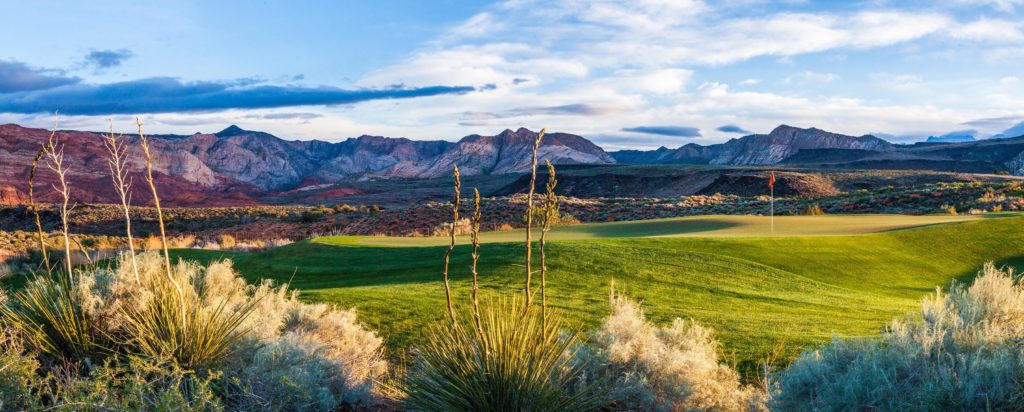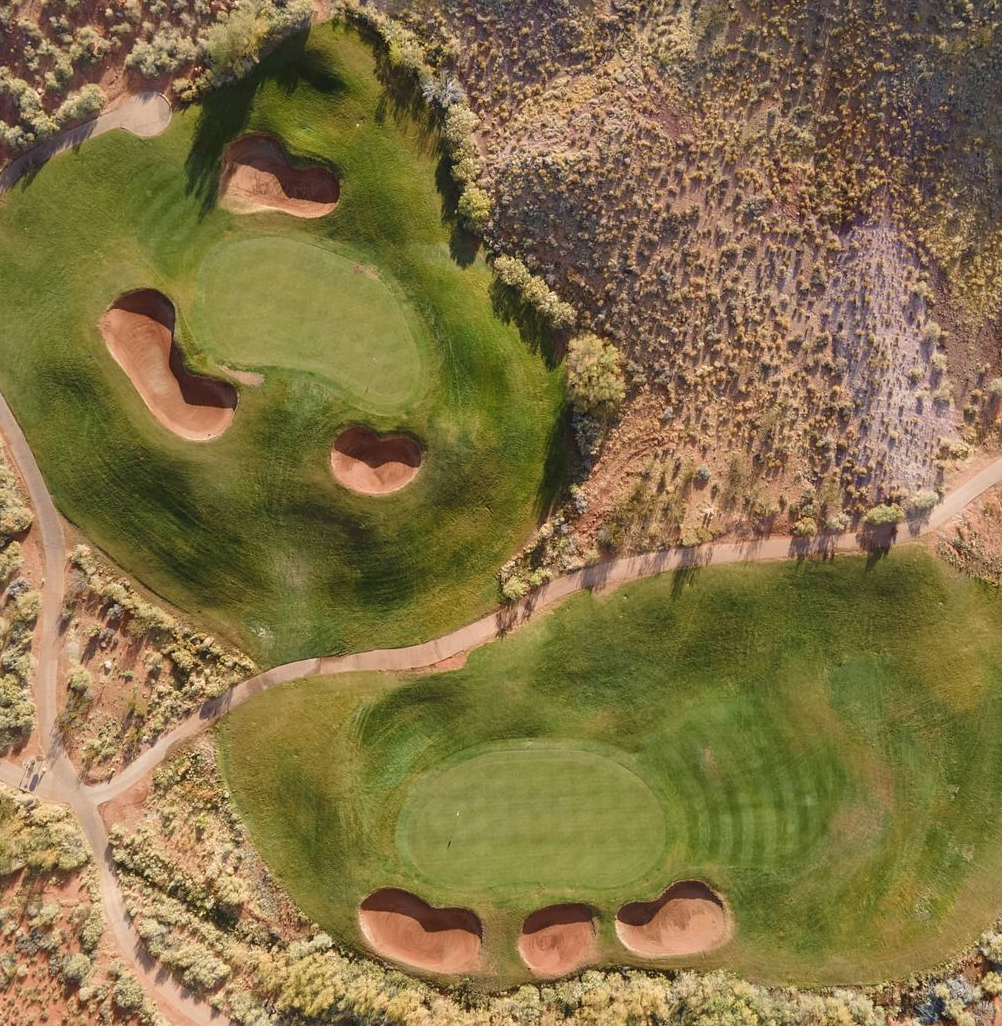
Coral Canyon
The area surrounding St. George, Utah, is often called “color country” for its spectrum of reds, blues and greens and their myriad variations, all surrounded by the Pine Valley Mountains and punctuated by the presence of Zion National Park so close one can almost reach out and touch it.
This palate of nature at its finest – and southwest Utah’s rolling, rocky, canyon-filled terrain – has become a mecca for golfers, both tourists and residents, alike. The southwest corner of Utah is renowned for its quality of life and low cost of living. The area has also become a haven for great golf because of the variety of its courses, a temperate climate that allows year-round play, and a nice combination of affordable package deals and quality lodging.
St. George is the business and cultural hub of the region, which is known as “Utah’s Dixie,” a moniker that stuck because of the weather and when Mormon pioneers grew cotton in the warm climate. The area, located about 120 miles northeast of Las Vegas, has been one of the fastest growing metropolitan areas in America over the past three decades, with many new residents flocking to buy second homes or just leave the big city and roost in a place where things move slower and the people are friendlier.
The region’s trademark is its red bluffs, which make up the northern part of the city, with two peaks covered in lava rock at city center. The northeastern edges of the Mojave Desert are visible to the south, the sublime Zion National Park can be seen to the east and the Pine Valley Mountains loom to the north and northwest. Let’s see – great golf, year round, friendly folk, a slower pace – sounds like a place I wanna go and stay a while.
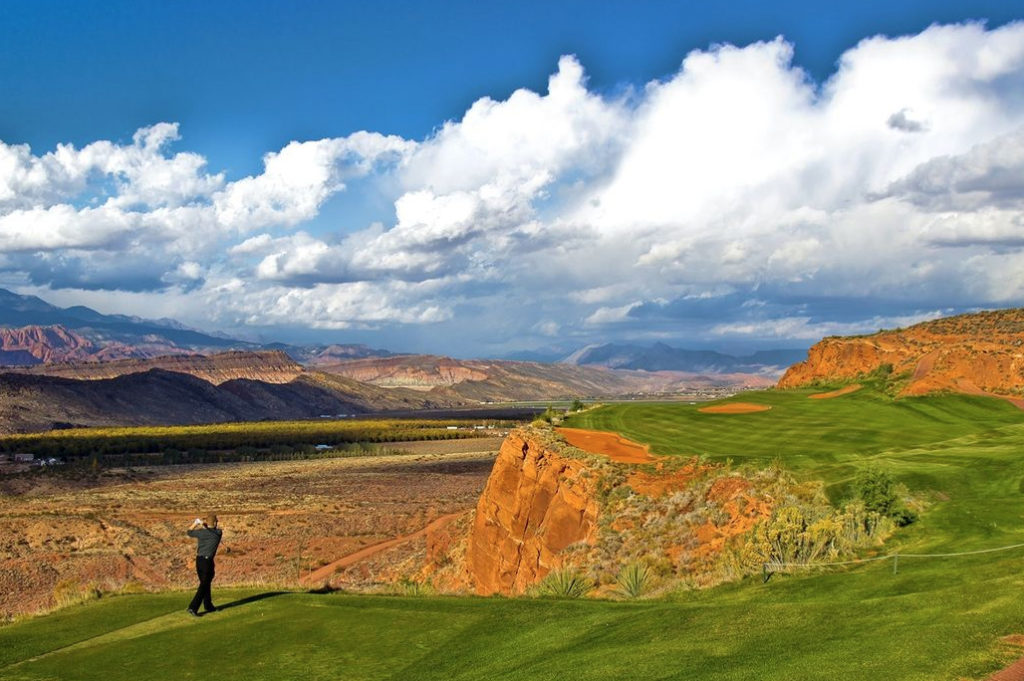
Sand Hollow Championship Course
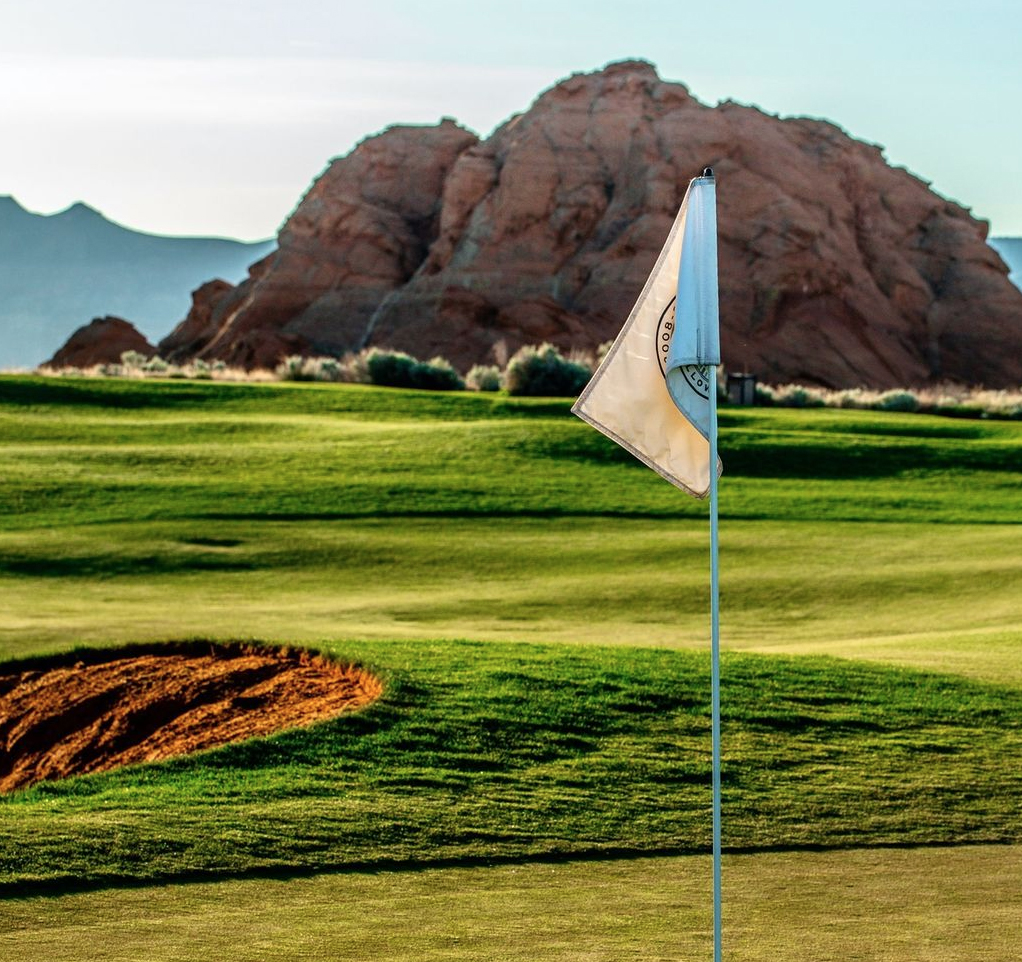
Sand Hollow Links Course
Foster, Fought hit the jackpot with sublime courses
This rocky, rich, vibrant landscape allowed two of the most noted golf course architects of the past 30 years, Keith Foster and John Fought, to fashion spectacular courses that both beguile and test even the best players.
Foster’s Coral Canyon and Fought’s two courses at Sand Hollow Resort are just a few miles from each other as the crow flies, northeast of St. George in the towns of Washington and Hurricane, respectively. The tracks are perhaps the most renowned of the 13 courses that are marketed together as the Red Rock Golf Trail, and rank among the best double-shots of golf anywhere in the western United States.
Wow factor kicks in at Sand Hollow
It would have been a blast accompanying Fought – the 1977 U.S. Amateur champion and a winner on the PGA Tour before he turned to golf course design – during his initial visits to the site that would eventually become the Championship Course at Sand Hollow Resort.
Sand Hollow is a stunning example of a designer making the absolute best of the land he is given, even if some of it is strewn with huge rocks and impinged by dramatic drop-offs. This is a course everyone remembers and is a great melding of grip-it-and-rip-it strategy and finesse.
Opened in 2008 and stretching 7,315 yards, Sand Hollow’s Championship Course has been lauded by many as the best track in Utah; it is certainly one of the most picturesque.
The front side is routed across a huge rolling plain above a valley bordered by the region’s red rocks. The holes here are long and demanding (there are four par-4s, including the 493-yard sixth) that play 433 yards or more, but it’s the huge greens that will take the biggest toll on even the best putters.
The incredible back nine begins with an expansive 565-yard, downhill par-5 which forces players to decide whether to challenge a collection of bunkers on the left in an effort to shorten the hole. The fairway then starts climbing and creates a mostly blind approach shot when attacking the green from more than 200 yards out.
The real wow factor gets turned up a notch at the 190-yard, par-3 11th and continues through the side’s other one-shotter — the unbelievable 230-yard 15th. This stretch of holes on the Championship Course plays along some of the most unique topography anywhere.
The vista across the huge plain leading back toward St. George is spectacular from the 11th green, and the 433-yard par-4 12th (like several of the holes here) has towering red rock to the right and a cliff wall to the left before the player reaches a slightly raised green in a bowl created by the surrounding rock.
The 320-yard, par-4 13th plays over a ridge with a narrow landing zone. The hole is drivable and features a 100-foot-tall cliff running along its entire left flank. With the potential of driving the green, the fear of the cliff edge to the left and the fantastic setting, this is a heck of a hole.
Just surviving the 525-yard, par-4 14th is pretty impressive. Playing the approach to the right and letting the hill filter the ball back towards the putting surface is how it’s done, effectively eliminating the cliff edge that borders the entire left side.
The 15th is a very cool hole as the white tees are reached by skirting the side of a huge boulder and walking through a semi-tunnel that’s natural rock. It’s a signature one-shotter that demands accuracy; anything left is gone and anything short will roll down to the rocks.
Sand Hollow’s Championship Course is the perfect balance of links golf and Southwest Utah desert landscape. “Each hole is a difficult birdie but easy bogey, so all levels of players will enjoy playing again and again,” Fought said of his creation.
Sand Hollow Resort offers players the Fought-designed, nine-hole par-36 Links Course as well as spacious practice facilities and an 18-hole, natural-grass putting course.
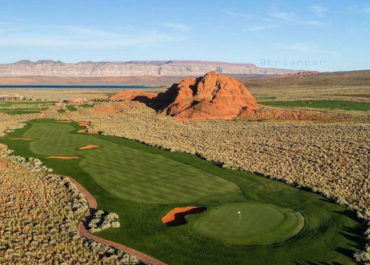
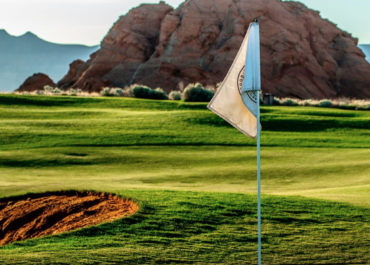
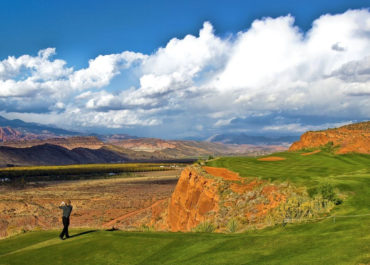
Forced carries, risk-reward opportunities mark Foster’s work
Building a golf course in a desert-scape usually forces architects to design holes with forced carries and narrow corridors. That’s not always a bad thing, especially when such a routing is in the hands of someone like Foster, a master of the target-golf genre.
With Coral Canyon, which runs through lower lands then rises up toward the snow-capped peaks of nearby Bryce Canyon, Foster built mostly wide fairways and greens that allow players to run up shots or to fly it all the way to the pin.
Fashioned to fit seamlessly into its natural environment, Coral Canyon works its way around some of the area’s natural land formations and lets players experience pure golf in the near-isolation of the pristine Utah desert.
Situated at an elevation of 2,800 feet, Coral Canyon is a challenging track, playing as a par-72 and at 7,070 yards from its back set of five tees. It is the centerpiece of a burgeoning 2,600-acre master-planned community. Foster carefully placed the 80 acres of turf, 55 bunkers and two lakes into the desert without disturbing an indigenous landscape interspersed with huge boulder and rock outcroppings, deep canyons and ravines, and all kinds of flora and vegetation.
The track begins with back-to-back par-5s (525 and 560 yards, respectively) that move down a hill and back up it around the driving range. The second hole is split in half between the target fairways and a pair of bunkers just short right of the green.
Coral Canyon‘s 163-yard, par-3 sixth is considered by many to be the track’s prettiest hole. It’s played across a deep ravine with no room for error and with a 20-foot-high red rock back of the green.
That challenge is countered by the 480-yard par-4 seventh, where the tee shot must be threaded between three fairway bunkers. After No. 7’s gauntlet of challenges, the 312-yard par-4 eighth seems inviting and where one could get back a stroke. But beware of the huge boulder just off the tee that will reject any low drives and the well-positioned bunker in front of the green.
The ninth at Coral Canyon is the only hole where water enters play. The lake runs along the right side of the fairway at the dogleg all the way to the green.
The meat of the course is a trio of holes that comprise the longest pars. No. 13 is a 229-yard par-3 with a large bunker on the port side of the green and a slope that exacerbates misses long or left. The 14th is a carded at 593 yards and moves slightly right to left in the fairway. The 15th, a killer two-shotter of 488 yards, has a generous fairway and just one bunker blocking the right side of the green, but is still all a golfer can handle.
The 555-yard, par-5 closer is a great test, moving slightly uphill and off-camber to the left, bringing the desert (and a dry gulch) into play.
Generally speaking, Foster’s work at Coral Canyon allows for a little wildness off the tee as recovery is possible from the encroaching desert. Coral Canyon has been voted a “Top 50 Golf Course for Women” by Golf Digest, evidence of its fairness and playability.
Perhaps the aspect that separates Coral Canyon from many other courses is the great rhythm of its design, which is obtained by a nice mix of challenge and beauty. It’s a fun track and a must-play when in southwest Utah.
Other courses are far from B-sides
Once folks decided to move here, developments began to pop up all around, and there is seemingly a neighborhood in St. George for everyone, from the fixed-income retiree to the middle-class workingman to those looking for a second home away from the hustle and bustle of Las Vegas, Denver or Los Angeles.
Two area golf courses — the city-owned, 27-hole Sunbrook Golf Club and the exclusive (but not too exclusive) Valderra at The Ledges Golf Course — illustrate the different flavors of golf and golf communities that whet the palate in St. George. Both are excellent tracks and staples of the Red Rock Golf Trail’s offerings for players looking for great courses at reasonable prices.
After all, if you can get golfers to your town and they like what they see and experience, maybe they’ll come back and stay. It’s a heck of a concept, right?
Three times the fun at Sunbrook
Ted Robinson designed the first two nine-hole sides at Sunbrook (the Pointe and Woodbridge), which opened in 1990, while John Harbottle fashioned the third set of holes (Blackrock) that debuted seven years later.
All three courses run through the neighborhood that shares a name with the golf facility, but the entire community is an example of residential golf done right.
The Pointe plays at 3,397 yards from the back set of four tees and provides the top territorial views at Sunbrook. The venue’s name derived from its most famous hole — the downhill 320-yard fifth, which starts with a little dogleg and ends at a putting surface that some of the most far-reaching vistas in St. George. Its green is next to a cliff, and if a player misses the putting surface on the left, the ball will drop down more than 100 feet to the second hole below.
The par-4, 441-yard sixth at Woodbridge uses a beautiful country-style wooden bridge (that’s where the nine gets its name) to move players from one side of the large fairway to the other. After teeing off from a bluff overlooking the island from the previous hole, golfers have to hit the ball well enough to make it past the lake.
The Blackrock nine weaves alongside the Virgin River until reaching the dramatic black lava that gives this course its name. The sixth (a 460-yard par 4), seventh (441-yard par-4) and the eighth (197-yard par-3) comprise the best stretch of holes at the entire course because there is no room to stray off the fairways, which are lined with punishing and ragged lava rock.
Of this trio, No. 7 is likely the most memorable hole at Blackrock. The tee is surrounded by lava and the approach is played across more volcanic remnants as well as a small lake strategically placed right of the green.
Blackrock (3,384 yards from the tips) has six forced carries on its nine holes, although half are right off the tee. It’s the narrow approaches that provide the real test here.
Golf Digest has twice rated Sunbrook as the best golf course in Utah. The biggest draw about the facility is variety. Its three nines provide many different looks and require players to use virtually every club in the bag.
Get your lava fix at Valderra Golf Club
A little north and west of St. George on an isolated plain and rolling river bed some 900 feet above the St. George valley is the 7,145-yard Valderra Golf Club at the Ledges. The layout is the centerpiece of a community with upscale homes and a wonderful clubhouse, spa and resort.
Designed by Matt Dye (Pete’s grandson), Valderra is like two courses in one. The first 10 holes and the closer cross a mesa that can lull you to sleep with its wide fairways and huge greens. Nos. 11-17 are hard against the cliffs in Snow Canyon State Park and involve a desert landscape dotted with red rock and daunting low-sided canyons. Here, the course becomes pinched and demanding, with the greens smaller and more undulating.
The fairways on the front side have some wavy landing areas and very large hills in the rough; the final eight holes are definitely tighter. Many of these elevations have been replaced by desert sand or red rock canyons. Miss a fairway on the back and you may never find your ball.
Despite the dramatic differences in Valderra’s front and back sides, Dye’s work around the greens is what unites the two nines. The putting surfaces and their surrounds require the golfer to be able to lob, chip, or pitch the ball to spots with spin to get close to the pins.
The 531-yard, par-5 11th starts the journey into the rocks. The views of Snow Canyon from the green at the 169-yard par-3 12th might stun golfers for a minute or two. Focus is required to successfully play the 419-yar par-4 13th — a hint: everything moves away when you are in the fairway; bet your partner that he can’t keep his approach on the green.
The 320-yard, par-4 15th seems like a chance to get greedy, but instead let prudence rule and play into this demanding putting surface with a high-lofted club. The tee shot on the 600-yard, par-5 16th will need to carry trouble; how much the player wants to cut off makes this hole a dandy.
The Mission-style clubhouse at Valderra acts as the focal point and social center of the neighborhood.
These four courses are just a primer to the great golf options in the St. George area. There are plenty of stay-and-options in the area, but a word to the wise – this place usually rolls up the sidewalks pretty early.
